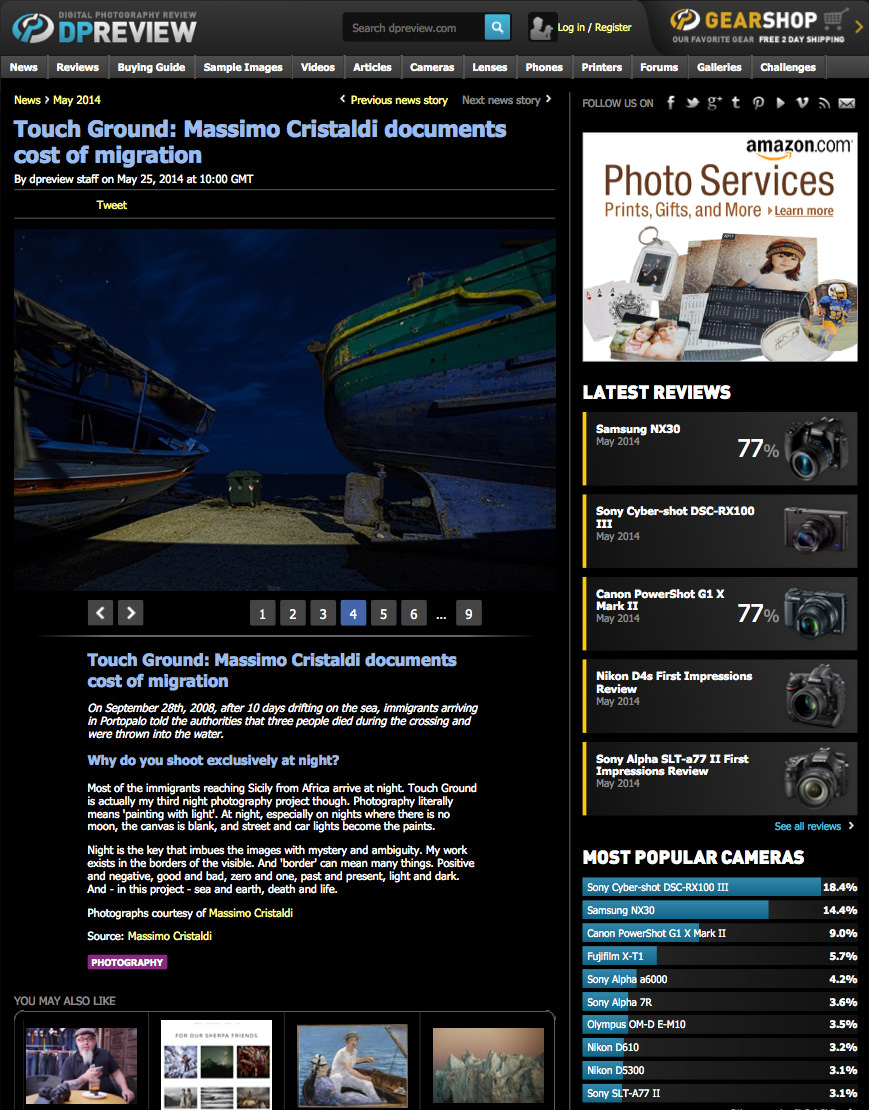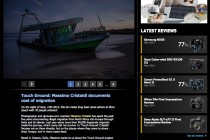Touch Ground has been today published by DPReview.com.
Touch Ground: Massimo Cristaldi documents cost of migration
Photographer and dpreview.com member Massimo Cristaldi has spent the past five years documenting illegal migration from North Africa into Europe through Sicily and its islands. Last year alone more than 40,000 desperate migrants made the journey, which many did not survive. In ‘Touch Ground’ Cristaldi focuses not on them directly, but on the places where they came to shore – tired, hungry, and in many cases dead.
Based in Catania, Sicily, Massimo spoke to us about the Touch Ground project. You can read his responses to our questions (and see more images) in this slideshow.
Why is this project so important to you?
MC: I believe that photography should raise awareness. But today we’re inundated with explicit images that make us indifferent to big tragedies. I wanted to explore this issue by capturing traces of tragedy – showing the places where often tragic events happened, not the events themselves.
I’m working from two perspectives – as an outsider who is raising awareness of a dramatic migration, but also as someone who lives in Sicily. So I want to show these locations as they exist from two different points of view – as the ‘promised land’ for the immigrants, but from the perspective of a Sicilian, just the sea. Just the beach.
How much impact does the immigration have on your community?
There are several levels. The first one is just emotional – hearing news of people who’ve died in the sea that I love. How this is even possible in 2014? There’s a logistical impact too, as the authorities try to tackle this difficult situation. The luckiest immigrants – those who survive the crossing – are detained for long periods of time in facilities where they wait for their asylum applications to be processed. Sometimes they’re waiting, segregated inside these facilities, for longer than a year. But then, sooner or later they’re released and the local community comes into contact with them, or they simply escape and find a way to live.
I have personally met many immigrants that now live and work regularly in Sicily. They all came via the same route, from far away and in miserable conditions. They have told me their stories, and what it meant to them to finally touch solid ground after weeks of being on the sea. Hearing those stories I felt I had an obligation somehow to create awareness of what is happening.
Why do you shoot exclusively at night?
Most of the immigrants reaching Sicily from Africa arrive at night. Touch Ground is actually my third night photography project though. Photography literally means ‘painting with light’. At night, especially on nights where there is no moon, the canvas is blank, and street and car lights become the paints.
Night is the key that imbues the images with mystery and ambiguity. My work exists in the borders of the visible. And ‘border’ can mean many things. Positive and negative, good and bad, zero and one, past and present, light and dark. And – in this project – sea and earth, death and life.
Can you describe your working method?
I started this project about five years ago. It took a lot of time to locate the places where the arrivals happened, scout them and then capture them. The project covers many different locations in Sicily and its islands and I’ve used plenty of cameras, all digital. This ‘all digital’ approach was new to me.
Most of the photographs are taken on a tripod using Canon EOS 5D Mark II and Mark III bodies with Canon’s 17mm tilt-shift lens. More recently I’ve also been working with a Sony A7R with the lens attached via a Metabones adapter. Some of the photographs were taken with Fujifilm X100 and X100s which have excellent high ISO performance, so I was shooting hand-held with those cameras.
Everything is captured in Raw mode, but with very little in the way of post-capture adjustment.
Is your style inspired by any particular photographer/artist?
I should mention [California-based contemporary artist and photographer] Todd Hido. I love his night photographs.
Your images are not typical documentary. Why did you decide to focus on the absence of the migrants?
It makes you guess, and imagine what it must have been like. For me personally, working at night, this was overwhelming. The project is very emotional for me, knowing what happened in those places.
What changes would you like to see socially and/or politically in relation to this issue?
Politically, I wish there was more European involvement. We don’t have the resources in Italy to deal with something that is becoming a problem for the entire continent. The ongoing “Mare Nostrum” mission, which involves Italian military vessels has rescued more than 30,000 people at sea. In this respect it has been a success but unfortunately, because more people are surviving the crossing it has lead to criminal gangs in North Africa putting even more people on boats.





















